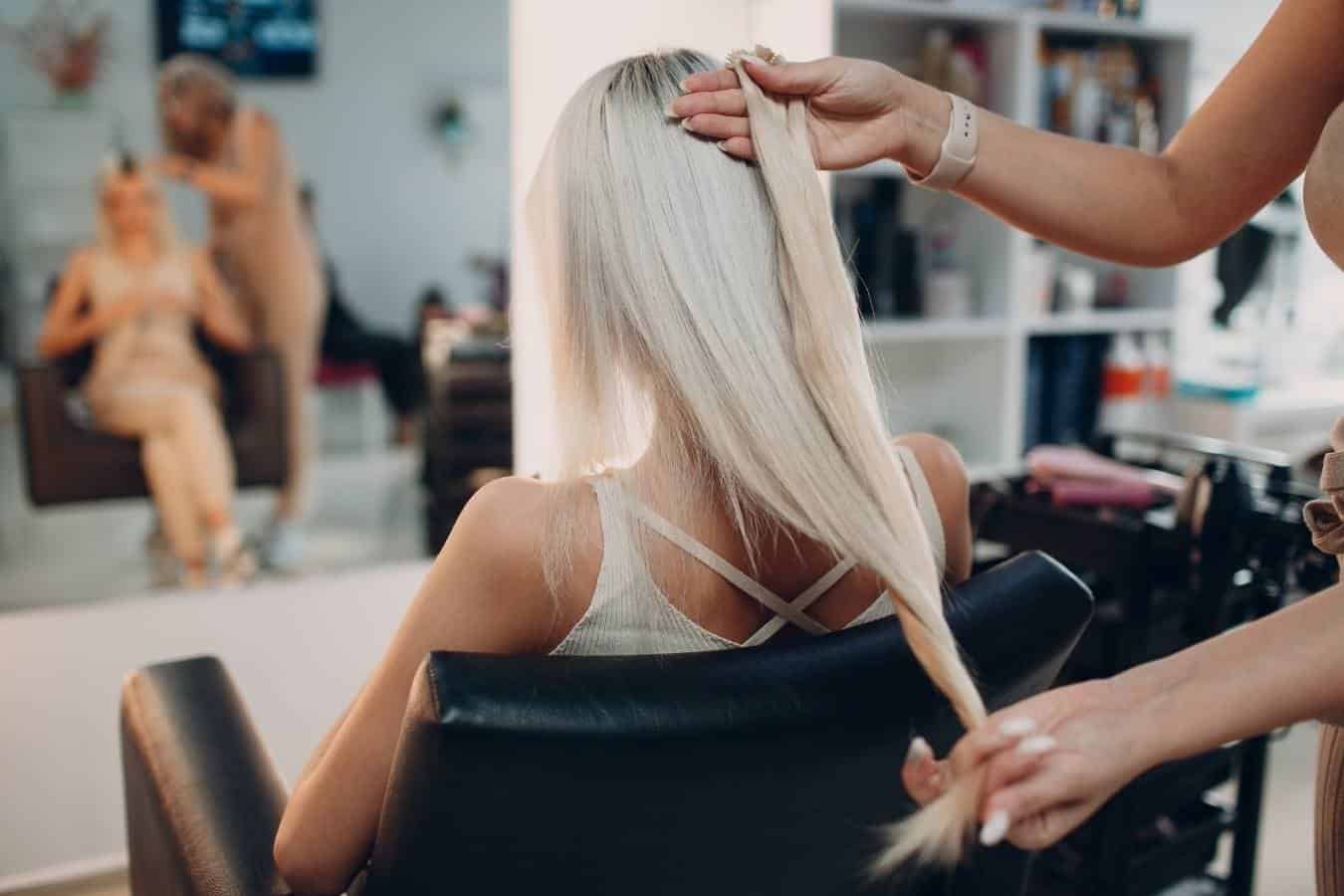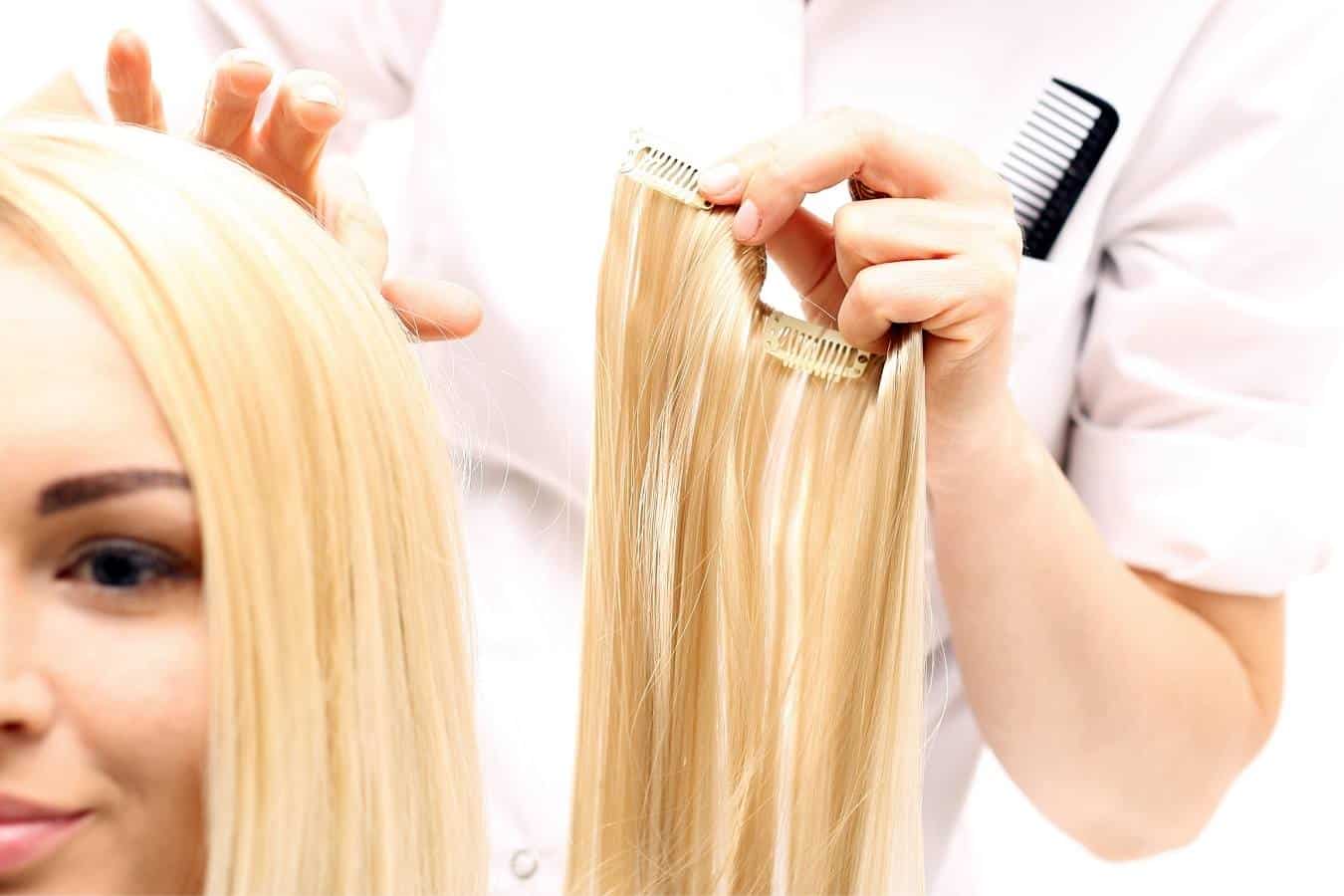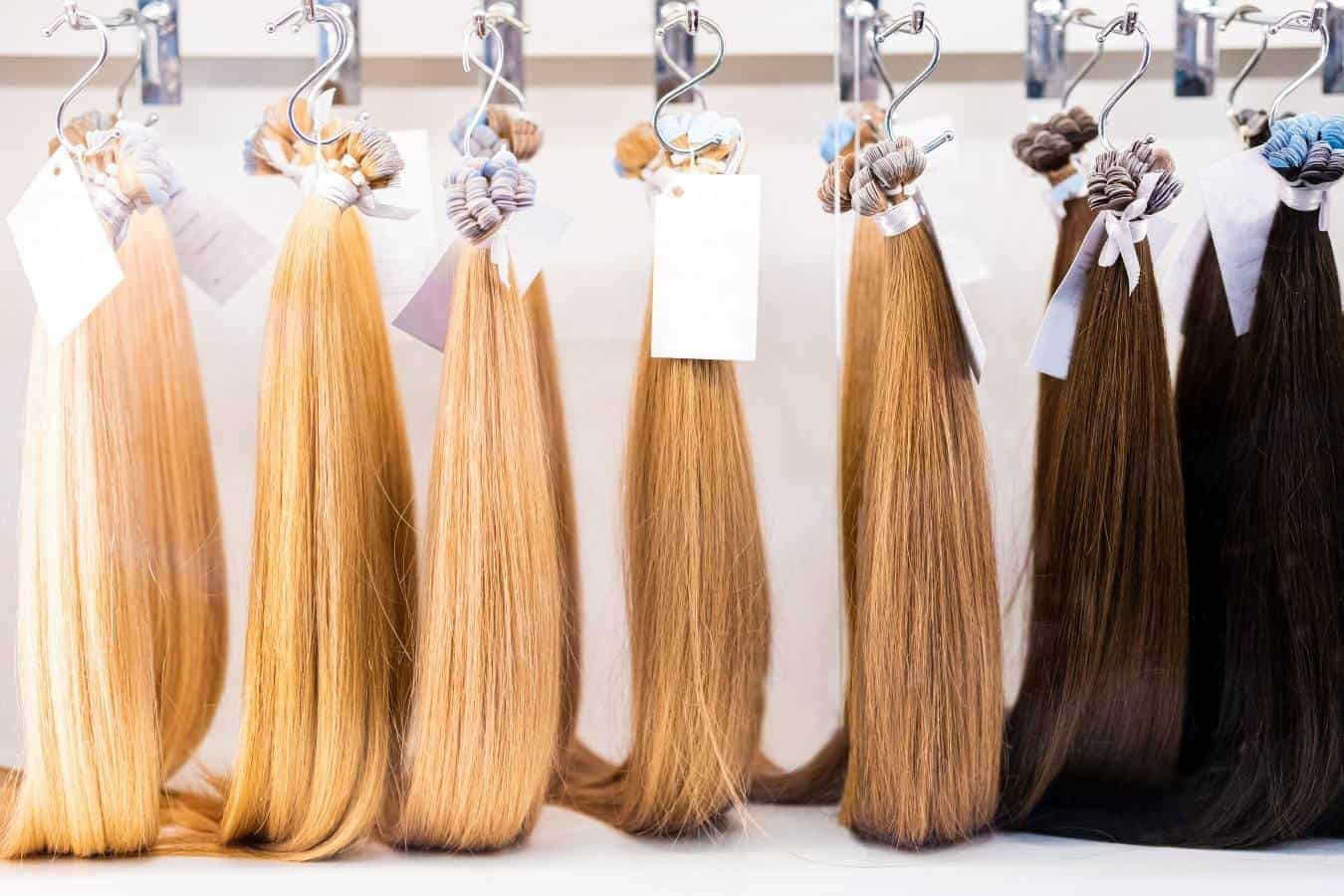Finding the right hair extensions can be challenging, especially if the color is too dark. But is it possible to bleach hair extensions?

The good news is that yes, you can in fact bleach your hair extensions – but only if they’re made of natural hair. Synthetic hair extensions won’t take well to either bleach or dye, so it’s best to avoid trying either.
Types Of Hair Extensions
There are two main kinds of hair extensions: natural and synthetic.
Natural hair extensions are made of human hair.
They’re usually collected from a donor, and the best kind is known as Remy hair extensions.
If you find Remy hair extensions, it means that all of the hair’s cuticles are intact, which ensures that the extension remains silky smooth and untangled throughout its lifespan.
Synthetic hair extensions are – you guessed it – synthetic.
They’ll typically be made of very fine plastic fibers that are made to simulate the look of human hair.
They’re more easily damaged by the sun or harsh products and will style less well than human hair extensions.
Hair extensions will typically also come in five different types, varying from clip-in through to micro links.
Can You Bleach Synthetic Hair Extensions?

You can’t bleach synthetic hair extensions. If you do so, they will very likely color differently from how you wanted them, and may even melt or warp because of the bleach.
Bleaching is an intensive chemical process, usually containing an oxidative agent and ammonia or peroxide.
When this interacts with the synthetic fibers of hair extensions, they may cause them to disfigure.
At the least, you probably won’t end up with the shade that you wanted them to be.
Hair dyes are made for human hair, so they just won’t work on synthetic hair extensions.
Synthetic extensions also are designed to last that long – typically for a few months – so they’re hardly worth the hassle of bleaching and coloring, anyway.
Can You Bleach Human Hair Extensions?
Human hair extensions are the only kind of hair extension that you can bleach. You should still be aware, however, that the bleaching process may cause damage, and it will impact the elasticity and moisture levels of your extensions.
You can color human hair extensions in the same way that you would normal hair.
Remember, as these don’t have a natural source of oil, these extensions are likely to dry much faster, so you’ll need to take care to moisturize them properly.
Bleaching will also likely impact the lifespan of your extensions.
If you’ve colored your (human) hair extensions and find them turning either red, pink, or purple, that unfortunately means that the extensions were in fact synthetic.
That said, if you’re trying to bleach your hair extensions but finding yourself unsuccessful, it may be that they’re covered in a sealant.
This is a kind of coating that’s designed to lock in moisture levels, so as to prolong the amount of time your extensions look glossy and healthy.
If your extensions have a sealant, however, this might block the bleach from doing its work. You can try to manage this by using a clarifying shampoo.
Can You Tone Hair Extensions?
Toning hair extensions is by far one of the best ways to change up the color of your hair extensions.
If your blonde hair extensions are looking a little ashy or brassy, you can tone this color out by using a product with warm orange undertones.
Alternatively, if your hair extensions are showing unwelcome red or orange flashes, go for a blue shampoo.
Purple shampoos are good for helping blonde hair extensions that are looking a little yellow and straw-like.
How To Bleach Hair Extensions At Home

It’s always worth heading to a salon so that a professional stylist can help you bleach and color your extensions.
That way, you’re ensuring that you won’t damage them, and can rest easy that they’ll come out the tone you intended them to.
That said, there are ways to bleach hair extensions at home. Remember to always strand test.
If you strand test one small section or clip of your extensions, you can check that you’re happy with the bleaching process before jumping in and applying it to all of your extensions.
Otherwise, follow these instructions for how to bleach your hair extensions:
1. Wash the extensions
Use a clarifying shampoo that’s free of chemicals to wash your hair extensions. This will remove any product build-up and will help to counteract any sealant that may be on the extensions.
Remember to let them air dry, and lay them out on separate sheets of kitchen foil ready for bleaching.
2. Ready your bleach kit
It’s important that you do your bleach research.
We recommend using a lower developer so as to cause minimal stripping of moisture.
However, if your extensions are darker and you’re looking to go lighter (we don’t recommend this), you’ll need a more intensive one.
Follow the manufacturer’s instructions for mixing the bleach and developer. The ratio is important, so be sure to take the guidance seriously.
It helps to do this in a glass bowl so that you can see the proportions of the product you’re mixing.
Opening a window can also help to ensure you don’t get a headache from the bleach smell. Remember to wear gloves – this is essential so as to avoid chemical burns.
3. Apply the bleach
Work the bleach into the extensions. Ensure that you apply it to both sides of the extension, and going in one direction will help with ensuring thorough saturation.
This ensures the even distribution of bleach and should help to prevent it from looking patchy and uneven.
Start from the top of the extensions and work down to the ends.
Avoid stroking your applicator brush upwards, as this will damage the extensions and may cause frizz, tangles, or breakages.
4. Wrap the extensions up in foil
When you go to a salon for a color appointment, you’ll notice that your stylist sections your hair and wraps each section in foil or saran wrap.
This is done because bleach works most effectively in a warm and moist environment.
You need to mimic this when wrapping your hair extensions.
Take care that you’re folding the foil so as to create a warm environment, and ensure that all of the extension is enfolded.
5. Check up on the bleach’s progress
Every 10 minutes or so, you want to be checking on how the bleach is working. Fold back a tiny layer and see what the extensions look like.
Remember, a higher volume developer will bleach them must faster. They’re good to go when they’re a shade of light yellow.
Top tip: when you’re bleaching your hair extensions, using kitchen foil is great – but if you want to make it even easier for yourself, you could use saran wrap.
Because it’s transparent, it makes it easier to check on the progress of the bleach.
With foil, you have to unfold a small section every so often in order to see how the bleach is working, but the transparency of saran wrap means this is avoidable.
6. Wash your extensions
This is a critical step, as it will prevent the bleach from processing on them any further, which may lead to serious drying.
Go for a pH-neutral shampoo and be sure to get any bleach out.
7. Condition your extensions
Remember how we said that extensions are likely to become dryer because they don’t have a natural source of oil?
Bleach will work to dehydrate them, so use a deep conditioning treatment to restore hydration.
Look for products that are humectant-heavy, so as to draw moisture in from the surrounding air.
Then seal the moisture into your extensions with an oil like coconut, argan, castor or olive oil.
Things To Be Careful Of When Bleaching Hair Extensions
The color of your extensions
If your hair extensions are dark and you’re trying to bleach them blonde, you’re going to run into some issues.
Remember that bleaching is severely drying for your hair, so your extensions may become so dehydrated and frazzled that they are unpleasant in texture, and lose their glossiness.
You’re probably better off buying some blonde extensions instead.
Don’t try to fix a mistake
If you’re trying to bleach your extensions so as to cover up a mistake you’ve already made with bleaching them – don’t.
Layering on bleach and colors will only strip them of any hydration and you’ll have totally ruined them.
Avoid using products with sulfates or alcohol
Chemicals like sulfates, alcohol, phthalates, and parabens – all of these frequently feature in haircare products, but they strip strands of their moisture.
If you’re bleaching hair extensions, the moisture in them is even more precious, so it’s best to avoid any products with these ingredients in them.
Remember to moisturize
Your hair extensions need moisture, and will always benefit from some TLC – particularly if you’ve bleached and colored them.
Use a deep conditioning treatment in order to restore and nourish your extensions following the bleaching process.
Products containing oils like coconut and olive oil are fantastic, and you want them to contain lots of water, too, which is a humectant that draws moisture into the strands.
It’s best to use a semi- or demi-permanent color
If you’re looking to color your hair extensions, these colors will change up your look without lasting for too long, and they don’t cause as much damage.
Using a low volume developer (around 10 in strength) is also best, as it won’t cause as much lift to the cuticles of the hair extension, and is, therefore, less invasive.
Disclaimer: This site is not intended to provide professional or medical advice. All of the content on LovedByCurls.com is for informational purposes only. All advice should be followed at your own discretion. Ingredients may change at any time so always check the product label before using. Check our full disclaimer policy here.
